How the Government Turned Comic Books Into Propaganda
The use of government-issued comics for purposes of indoctrination.
Comic books, psychiatrist Fredric Wertham argued in a 1953 Ladies Home Journal article that preceded his 1954 best-seller, Seduction of the Innocent, were instruction manuals for everything from shoplifting in department stores to tween lust-murder.
"If one were to set out how to teach children to steal, rob, lie, cheat, assault, and break into candy stores, no more insistent method could be devised," he wrote. And they were so perniciously persuasive, they were corrupting the nation's youth with startling speed, even making bad seeds worse. "Even psychotic children did not act like this fifteen years ago," he concluded after listing a series of gruesome crimes allegedly inspired by comic books.
The evil spell that comic books were capable of casting apparently got to Werthem as well. While his campaign against brightly inked mayhem inspired a U.S. Senate hearing that led to industry self-regulation and the demise of hundreds of crime and horror titles, Carol Tilley, an assistant professor at the University of Illinois Graduate School of Library and Information Science, has discovered evidence that suggests Dr. Wertham bent the truth to fit his theories in Seduction of the Innocent.
Tilley details her finding in the November/December 2012 issue of Information & Culture. Comparing the actual transcripts of the cases studies that Wertham purported to describe in his book—involving youth he'd counseled in a Harlem clinic he founded—Tilley found that he frequently omitted, amended, and recontexualized information in ways that "change[d] the kids' arguments or change[d] their viewpoints."
In light of Tilley's revelations, one can't help but wonder: Why didn't the senators who were giving the third degree to comic industry bigwigs like Bill Gaines question Dr. Wertham a little more assiduously about his work habits?
Government Issue: Comics for the People, a 2011 anthology compiled by Richard Graham, an associate professor and media services librarian at the University of Nebraska-Lincoln, suggests an answer: If there was any entity that believed in the power of comic books to indoctrinate and instruct as Wertham did, it was the U.S. government.
In 1931, Graham notes, media research pioneer George Gallup published an analysis of newspaper readers in Des Moines, Iowa, that "showed that the least popular comic strip in the Sunday funnies was more widely read than the lead news story in the paper, and that adults as well as children were avid readers of the Sunday comics section."
In short order, advertisers began presenting their pitches in the form of comic strips. A decade later, in the wake of an Advertising Research Foundation study that echoed Gallup's findings, the U.S. Army started publishing comic books designed to impart various lessons to its troops.
Over the next decade, as critics like Wertham ramped up their campaign against the increasingly popular medium of comic books, the U.S. government itself published dozens of comics, a practice it continues to engage in, even today. (The most recent comic that Graham highlights, Squeaks Discovers Type, was published in 2010.)
To see complete versions of more than 200 titles that the U.S. Government Printing Office, the U.S. Department of Labor, and countless other federal and state agencies have published over the years, see the online collection at the University of Nebraska-Lincoln's website.
Here are 5 notable titles the government published during the Wertham era.
1. The Life of Franklin D. Roosevelt, 32nd President of the United States
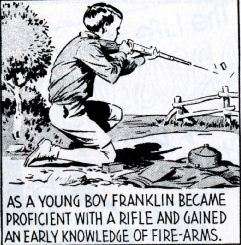
Artist/Writer: Unknown
Date published: 1943
Government agency: Office of War Information, U.S. Government Printing Office
"It's time for us to stop bureaucratic organizations from using public funds in such a way," charged Congressman John Taber (R-NY) in 1943 when, in the midst of World War II, the Office of War Information issued this 16-page cartoon biography of President Franklin Roosevelt.
Accurately noting the publication's lack of information that would be useful to soldiers on a fighting front, Taber characterized the effort as "purely political propaganda…designed entirely to promote a fourth term and dictatorship." According to him, it looked as if it were created by the artist "who gets up Tarzan for the funny papers."
Certainly it presents Roosevelt, who in addition to being paralyzed from the waist down, was then suffering from high blood pressure, coronary artery disease, and a range of other ailments, with Tarzan-like vigor. Kicking off with a panel that illustrates Roosevelt's shooting prowess as a young lad, the comic book presents Roosevelt as a rugged and dynamic presence, playing football at Harvard, sailing the high seas, restoring American prosperity with giant public works projects, and earlier in his life, sort of licking some mysterious malady that left him unable to be depicted standing up: "Roosevelt's determined fight amazed physicians. His recovery became almost complete…"
On November 7, 1944, President Roosevelt convincingly won his fourth presidential election. Score one for Wertham?
2. United States Marines #3: A Leatherneck Flamethrower
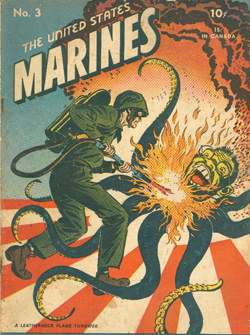
Artist: Mart Bailey, Wood Cowan, Ogden Whitney, Ray McGill
Writer: Milburn McCarty
Date published: 1944
Publisher: Government Enterprises
This commercial title, available at newsstands alongside the crime and horror comics that would cause such a national uproar during the late 1940s and early 1950s, was intermittently published by a private corporation but reviewed and cleared by the U.S. Marine Corp. Unlike government titles charged with turning sewage treatment processes or Social Security benefits into the stuff of page-turning drama, this title featured government work in all its two-fisted, action-packed glory, with page after page of machine-gun strafing, saber disembowelings, and other vividly rendered war-time carnage. Issues like this one also featured dozens of actual black-and-white photographs of Marines in combat—hanging out in foxholes, poking enemy dead with bayonets, carrying their wounded brethren on stretchers.
In Government Issue, Richard Graham notes that while many commercial newspaper comic strips featured content depicting the war, including depictions of "Nazis as Teutonic buffoons and the Japanese as blood-drooling torturers," the Office of War Information worried that such depictions were "too simplistic and could lead to over overconfidence" because they portrayed "the enemy as lazy and posing little threat."
Perhaps that's why on the cover of this Marine-approved comic, Prime Minister Tojo is depicted as a lively eight-legged sea-monster.
3. Foxhole on Your Front Lawn
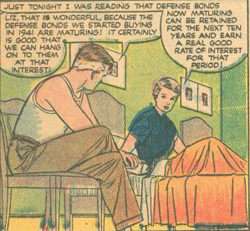
Writer: Charles Biro
Date published: 1951
Government agency: U.S. Treasury
If you suspect it might be hard to base a gripping comic tale on defense bond interest rates, you're correct. What makes this comic interesting is who created it—Charles Biro, the man behind the comic book series Crime Does Not Pay, which is credited with launching the crime comic genre. By the time Biro was helping the Treasury Department stave off the Red menace by illustrating the virtues of government bonds, Crime Does Not Pay was no longer quite as blood-soaked as it had been in the early 1940s. Nonetheless, the title was still going strong in 1951, and filled with fare like "Book of Sins" and "You'll Never Live to Tell." If Dr. Wertham was right about the influential power of comic books, then Biro can take credit for singled-handedly creating a generation of ruthless, patriotic, bond-buying thugs.
4. Chic Young's Blondie in "Scapegoat"
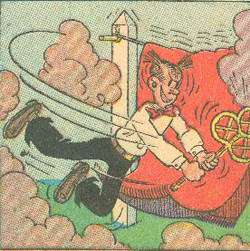
Writer: Chic Young
Date published: 1952
Government agency: State of New York Department of Mental Hygiene
In the crime and horror comics of the late 1940s and early 1950s, the henpecked milquetoast who slaughters his boss or mutilates his wife in some fiendish fashion—only to ultimately suffer some even more gruesome fate himself—was a recurring character.
In "Scapegoat," Dagwood Bumstead seems poised to go down this route. First, he fantasizes about choking out Mr. Dithers with a ferocity that makes the Hillside Stranglers look like Homer Simpson. Then, while trying to nap away his seething contempt for the world, he explodes at his family. Luckily, Blondie saves the day by teaching Dagwood how to manage his murderous outbursts by brutally assaulting a dusty rug. If this title ever inspired the nation's tots to go on a tidy rampage of therapeutic room-cleaning, Dr. Wertham never caught wind of it.
5. Johnny Gets the Word
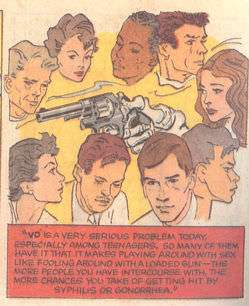
Writer: Unknown
Date published: 1957 (original version), 1965 (revised version)
Government agency: New York City Department of Health
In the late 1940s, as public sentiment against crime comics intensified, the comic book industry turned to romance titles as a source of less objectionable material. According to David Hadju's The Ten-Cent Plague, the industry was publishing 148 romance titles in 1950. In comparison, only 30 crime titles were being published at that time.
While Dr. Wertham worried that the close relationship enjoyed by Batman and Robin—not to mention their "sumptuous quarters, with beautiful flowers in large vases" and "beautifully landscaped" house—was instilling the nation's youth with homoerotic urges, Johnny Gets the Word suggests all those romance comics of the early 1950s might have had more impact. Published by the New York City Department of Health, it depicts the Big Apple as an extremely active matrix of heterosexuality, where pretty much every teen, even that "nice kid" Gloria, has got "the siff."


Show Comments (22)